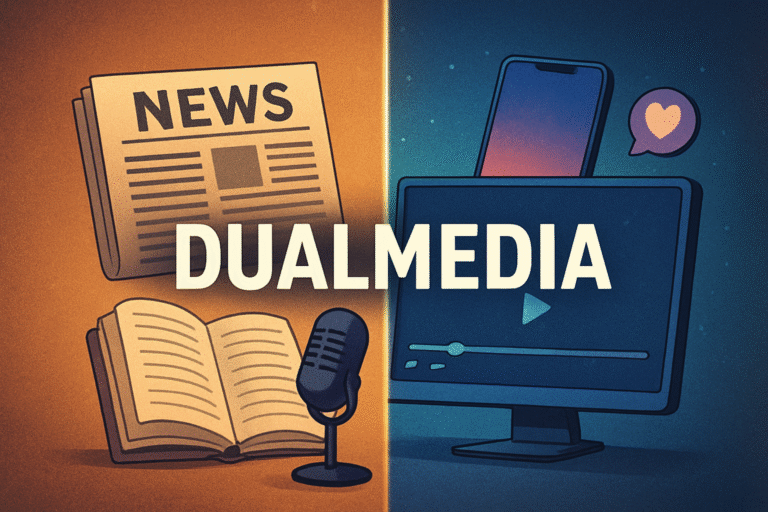Introduction
The world we live in is buzzing with more noise than ever before—news flashes, social media feeds, podcasts, YouTube shorts, streaming shows, and even holographic concerts. But in this whirlwind of communication, a new star is quietly emerging: dualmedia.
At its core, dualmedia refers to the fusion of two distinct forms of media into one cohesive narrative experience. Imagine a novel that seamlessly extends into an interactive web series, or a marketing campaign that exists simultaneously on a billboard and within a mobile game. That’s dualmedia at play.
But why does this matter? In a world where attention spans are shrinking faster than your smartphone battery, finding new ways to engage people isn’t just smart—it’s survival. Dualmedia isn’t just a buzzword; it’s a movement reshaping how stories are told, how products are marketed, and how humans connect with one another.
So, buckle up! We’re diving deep into the what, the why, and the how of dualmedia, and by the end, you’ll see why this hybrid storytelling model might just be the biggest leap forward since the invention of social media.
What Exactly Is Dualmedia?
Dualmedia, in its simplest form, is the blending of two different mediums into one integrated experience. It’s not about merely posting a TikTok alongside a blog—it’s about interweaving them so tightly that one doesn’t make sense without the other.
For instance:
-
A graphic novel that includes QR codes linking to short films.
-
A museum exhibit paired with a VR app that allows you to “step inside” the artwork.
-
A music album accompanied by an interactive app that changes visuals based on the track you’re listening to.
Dualmedia is immersive, engaging, and—let’s be honest—downright cool. It transforms passive audiences into active participants.
Why Is Dualmedia Becoming a Big Deal?
Here’s the thing: audiences today are more fragmented than ever. Some folks live on Instagram, others binge-watch Netflix, and a few might still flip through glossy magazines. Traditional “one-size-fits-all” media just doesn’t cut it anymore.
Dualmedia solves this problem by bridging different platforms and pulling audiences into a shared, interconnected experience.
The Big Reasons Behind Its Rise:
-
Short Attention Spans
People switch apps, tabs, and even thoughts in seconds. Dualmedia keeps them hooked by offering layered experiences. -
Technology Integration
Smartphones, AR glasses, and streaming platforms make it easier than ever to connect different media forms seamlessly. -
Demand for Interactivity
Audiences don’t just want to watch—they want to engage, play, and even co-create. -
Marketing Goldmine
Brands love dualmedia because it allows them to spread their story across multiple touchpoints without losing coherence.
The Building Blocks of Dualmedia
So, what makes dualmedia work? You can’t just slap a podcast on top of a movie and call it a day. True dualmedia has a few key ingredients:
-
Complementary Mediums – Each form should add something new, not repeat the same content.
-
Seamless Integration – The shift between media feels natural, not forced.
-
Narrative Continuity – The story flows smoothly across platforms.
-
Audience Empowerment – Viewers feel like they’re part of the journey.
Think of it like cooking: the best dishes aren’t made by throwing random ingredients together—they’re crafted with balance and intention.
Real-World Examples of Dualmedia
It’s not just theory; dualmedia is already happening around us, even if you haven’t noticed.
-
Netflix’s “Bandersnatch” – A TV show and video game hybrid, where viewers controlled the outcome.
-
Nike’s AR Billboards – Interactive outdoor ads that paired with a smartphone app.
-
Harry Potter Wizarding World – Books, films, mobile games, theme parks—all telling one giant, interconnected story.
-
Educational Apps – Schools now use textbooks paired with AR experiences that make historical battles or scientific processes come alive.
Challenges of Dualmedia
Of course, no shiny new idea is without its hiccups. Dualmedia has a few hurdles to clear:
-
High Costs – Creating across multiple mediums isn’t cheap.
-
Tech Barriers – Not everyone has access to AR or VR devices.
-
Overload Risk – Too much blending can confuse or overwhelm audiences.
-
Consistency Problems – Maintaining narrative flow across platforms is tricky.
But let’s be real: challenges are what make innovations exciting.
Dualmedia in Marketing: The Brand Connection
Marketers are especially giddy about dualmedia because it offers something traditional ads can’t: deep engagement. Imagine a sneaker brand launching both a TikTok dance challenge and an AR filter that lets you “try on” the sneakers virtually. That’s not just advertising—it’s storytelling that sticks.
Brands using dualmedia can:
-
Create stronger emotional bonds.
-
Encourage user-generated content.
-
Reach diverse demographics through different channels.
The Future of Dualmedia
So, where’s this headed? The possibilities are endless, but here are a few exciting predictions:
-
AI-Driven Narratives – Personalized dualmedia stories that adapt to your mood, behavior, or location.
-
Holographic Ads – Billboards that interact with your phone in real-time.
-
Cross-Reality Entertainment – Movies that spill into video games, which spill into live events.
-
Education Reinvented – Lessons that blend physical books, online tools, and AR classrooms.
How Can You Leverage Dualmedia Today?
If you’re a creator, entrepreneur, or even a teacher, you might be wondering—how can I jump on the dualmedia wave? Here’s a quick starter guide:
-
Pick Two Complementary Mediums – Choose formats that enhance each other (like print + digital, or video + interactive app).
-
Plan for Narrative Continuity – Your audience should feel like they’re moving through one seamless story.
-
Test Small Before Scaling – Try a pilot project before investing big.
-
Focus on Value – Don’t add a second medium just for the heck of it—make sure it truly adds depth.
FAQs About Dualmedia
Q1: Is dualmedia the same as multimedia?
Not exactly. Multimedia refers to combining multiple forms (like text, video, and images) in one platform. Dualmedia, on the other hand, bridges two different platforms or mediums into one integrated experience.
Q2: Can small businesses use dualmedia?
Absolutely! Even a coffee shop could print QR codes on cups that link to short videos about the farmers behind the beans.
Q3: Does dualmedia require advanced tech like VR or AR?
Nope. While tech helps, dualmedia can be as simple as blending a physical product with digital storytelling.
Q4: Will dualmedia replace traditional media?
Not replace, but definitely reshape it. Traditional forms will still exist, but dualmedia will become a dominant way to connect across platforms.
Conclusion
Dualmedia isn’t just a trend—it’s the next big leap in how we tell stories, share ideas, and build connections. From marketing campaigns to classroom lessons, from blockbuster movies to independent art projects, the blending of two mediums creates experiences that are richer, deeper, and infinitely more engaging.
We’re standing at the edge of something remarkable. The question is: are you ready to embrace the power of dualmedia? Because one thing’s for sure—once you’ve experienced it, plain old single-channel media will never feel the same again.

